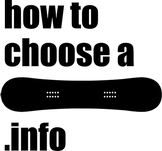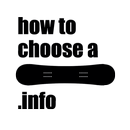Snowboard SHAPES
Looking for for the snowboard type? or maybe for the "true twin" and "directional twin" names / definitions?
Twin snowboard Shapes
This snowboard shape is better to ride and land in switch and to rotate in general. Twin shapes are mostly used in freestyle / jump / pipe / jib snowboards. Found in all the snowboards described as "true twins", in some described as "directional twins", and maybe even in some described as "directional".
On a snowboard with a twin shape, the shape in both sides (from tips to center) is equal.
(note: a snowboard called "true twin" has a twin shape, a twin flexibility, a twin profile and centered inserts, everything is twin, except for the graphics, those may be directional:)
Directional snowboard Shapes
Directional shapes may excel in going forward without the compromise of still having to ride great in switch, even though they may be able to ride switch, that surly wont be their strongest skill. They're usually made for specific end results like being better at carving / riding fast, riding powder effortlessly... Directional shapes are mostly used in snowboards made for powder / freeride / speed (carving) / all mountain. Found in snowboards described as "directional" and "directional twin".
On a snowboard with a directional shape, the shape is not the same on both sides. One or more of the following things occur:
(note: the most directional snowboard possible would have a directional shape, a directional flexibility, a directional profile and set back inserts, and would definitly be called "directional". A directional board that misses one or more of those directional specs. may be called "directional", "directional twin" or "twin", just not "true twin")
True twin / Directional twin / Directional NAMES (used by brands to help you choose your board)
True Twin snowboard
A true twin snowboard has the same size and shape in both sides (nose and tail) and the inserts are centered, making it equal on both sides (in both, shape and size). It also has a twin flexibility. This snowboards are better to ride and land in switch and to rotate in general. True twin shapes are mostly used in freestyle / jump / pipe / jib snowboards.

Directinal twin / Twin like / Twin snowboard
The terms may refer to snowboards that have the same shape in both sides (nose and tail) but the inserts are slighly set back, closer to the tail than to the nose. Or the inserts are centred (like a true twin) but there are little differences in the shape, the board may be tapered or the tip and tail may be different. They may even have a very small set back along with a small taper and some little diference between tip and tail, as long as that doesn't make them bad while riding switch. A directional twin snowboard will excel going forward (generally or in some specific situation, like riding powder) without taking anything away from the switch riding. Lot's of all mountain boards are directional twins.
(twin boards with centered inserts can also be called directional twin because of a directional flexibility wich can create some, or a lot of, confusion)


Directional snowboard
They may have the ability to ride swith but that won't be their stronger skill. A directional snowboard has a different size and shape on each side (nose and tail) and the inserts are set back, closer to the tail than to the nose. Or it has just one of those carateristics but really marked (it probably has a directional flexibility too). Directional shapes excel in going forward without the compromise of still having to ride great in switch, they're usualy made for specific end results like being better at carving / riding fast, riding powder efortlessly... Directional snowboards are mostly used in powder / freeride / speed (carving) / all mountain.


Asymmetrycal snowboard Shapes
What gives a snowboard an asymmetrical shape is the asymmetrical side-cuts. But asymmetrical snowboards can have an asymmetrical flexibility too.
Tapered snowboard Shapes / Pin tailed snowboards
Tapered means "a gradual decrease in thickness or width of an elongated object".
In a tapered snowboard the nose is slightly wider than the tail.

Volume shift snowboard Shapes (short and wide snowboards)
Volume shift shapes are also known as short and wide snowboards. This is not a detail in the shape of the snowboard that you can fell when snowboarding but it's not easy to see when looking at the board, It's such a drastic change in the typical snowboard shapes that creates a new category of snowboards, a new type of snowboard, so it is usually referred to as a snowboard type. This shapes have the same area as "normal" snowboard but are much wider and shorter. The first snowboards ever were more like this, before all the ski tech got involved, so this volume shift snowboard shapes kind of represent the snowboarding coming full circle and back to the idea of just have fun.
Great to ride trees, slush, powder on the slopes and generally goof around, they're like the park boards for powder.

